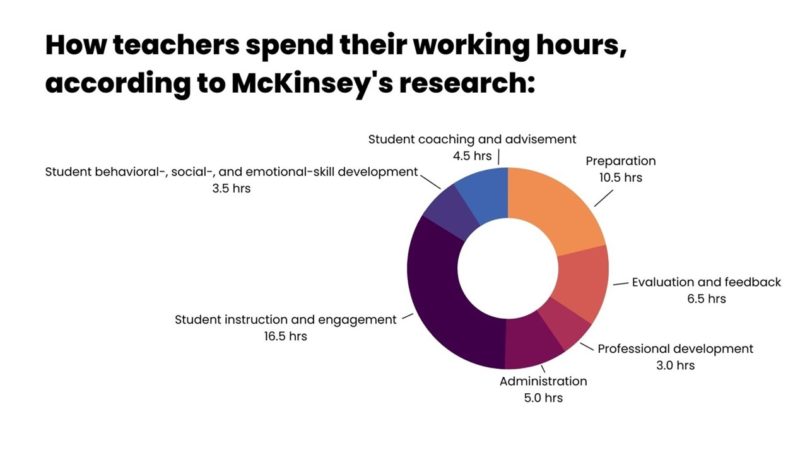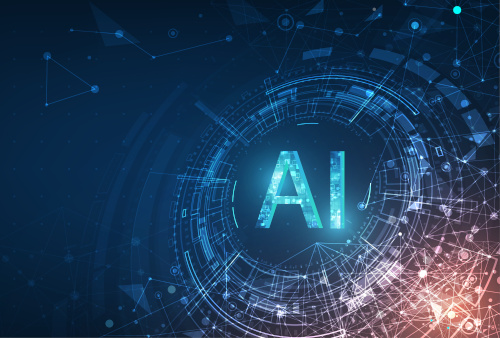Click Here for Everything You Need To Know About AI In Education
The teaching profession is in crisis. K-12 teachers report the highest burnout rate among all industries nationally, according to a June 2022 Gallup poll. Job satisfaction is at the lowest it’s been in 40 years. There is an estimated teacher shortage of over 300,000.
Many blame COVID-19, but if you look at the facts: the pandemic only revealed the cracks, long buckling under pressure.
But what if every single teacher could have an AI assistant? Would that change the game?
A similar question was asked by McKinsey three years ago, right before the worldwide pandemic caused the lowest reading and math scores in 30 years.
In summary, McKinsey’s pre-COVID answer was simple: “yes, but in time.”
That time is now. According to McKinsey’s 2017 study, the average teacher worked 50 hours a week (a number that has grown to 54 hours post-pandemic, according to 2022 research). Only 49 percent of this time involves direct student interaction. Indeed, the time spent on teaching class is less than the time spent on preparation, evaluation, and feedback (grading).

Using AI, we can eliminate much of the time teachers spend on preparation and grading—reducing their week by as much as 30 percent—and giving them more time for what they do best: teaching students. AI can also provide schools tools to foster a less stressful, more flexible work environment. Here’s how.
AI tremendously cuts down on lesson prep.
Preparing lessons is one of the more time-consuming parts of a teacher’s job. According to McKinsey’s study, teachers spend over 20 percent of their time just preparing for class. That’s over ten hours a week. An AI tech company can help by giving teachers the power of AI to scan text and turn it into well-designed slides. By simply sharing a link to a textbook or by uploading a PDF, the AI then auto-creates well-designed slides that teachers tweak to use for sleek lesson presentations. This could save teachers substantial time — while also creating more aesthetically-pleasing results—as most teachers aren’t designers!
AI reduces challenges with time off.
The substitute teacher shortage is dire and hinders a school’s ability to function. Far too often, teachers come to school sick due to the lack of substitutes. Schools must support teachers as humans; AI can help them reduce preparation time and act as an instruction supplement.
“We’re seeing a major shortage of substitute teachers,” says David McGrath, headmaster of Paragon Prep, a high school in Austin, TX. “Rather than putting a pause on instruction, how marvelous would it be if a teacher could program their own avatar to teach a lesson on a day they have to be out sick or at a conference? A staff member can sit in the room while the avatar plays on the screen.”
Schools can leverage the teacher’s AI-generated lesson on the same subject, while teachers can track and monitor a student’s progress. This gives teachers and the administration more flexibility when missing school days—whether it’s the teacher or a student missing class.
“As long as the teacher can shape the message and is programming the avatar to do their job for them, I think teachers would see this technology not as a threat but as an amazing tool,” explains McGrath.
AI transforms textbooks into interactive study guides.
As Gen Z prefers learning via video platforms like YouTube over reading, it’s clear that textbook publishers need to innovate and evolve in order to help students and teachers. New AI technologies can be used directly by publishers to auto-convert textbooks into engaging video lessons. This could save teachers tremendous time, allowing teachers to edit and personalize lessons for their classes without starting from scratch.
Students can read while listening and pause or rewatch when needed—making the interactive videos particularly helpful for those struggling with traditional studying forms. These videos benefit teachers who incorporate the “flipped classroom” methodology, which is increasingly popular and promising. With this technology, teachers could also leverage AI-generated avatars in their videos to make the lessons more interesting. For example, teachers could have Pythagoras explain his own theorem in ancient Greece, for example.
AI helps with automatic grading and assessment creation.
Teachers spend between five to seven hours a week grading. This is widely known as the worst part of teaching. AI can eliminate much of this.
With AI tools, grading becomes automatic. And with instant answers, students can better understand the concepts. AI can also reduce the teacher’s time creating questions, as it automatically generates possible learning assessments.
Furthermore, when it comes to subjects like math, AI can quickly adapt to a student’s level, so homework becomes a way to have a deeper understanding of a student’s mastery of a subject. For instance, AI can challenge certain students who need a challenge and slow down for students who need more time understanding the subject. In turn, this generates better insights into the teachers’ understanding of the student’s efforts.
Many fear that computer-generated grading would only perpetuate the education system’s reliance on multiple-choice questions. But with AI, that is simply not the case. When answering basic questions, AI can read a student’s answers. Perhaps it’s not ready to read a 5-paragraph essay on To Kill a Mockingbird, but it will know if a student paid attention when asked who Boo Radley is.
AI could transform tutoring.
A 2017 study found that tutoring is the most effective way to improve learning outcomes among students from low socioeconomic backgrounds. But most teachers, particularly in public schools, don’t have the time for one-on-one instruction with every student.
AI edtech companies like Hypatia are already making this incredible technology a reality. Technologies have tremendous potential to assist with tutoring as well. Will this replace the need for human tutors? Well, as a mother of two rambunctious kids, I think certainly not. After all, it’s widely agreed that lasting relationships are the key to the efficacy of tutoring. The idea that a robot can replace teachers is laughable. But can it be used as a low-cost, highly scalable tutoring supplement? Absolutely.
So, rather than worrying about how AI might replace teachers, the time has come to ask what AI can do for teachers?
Related:
AI’s promising reality in classrooms
AI is the key to scaling personalized, one-on-one instruction
- The evolving requirements of a K-12 school network - April 24, 2024
- A bungled FAFSA rollout threatens students’ college ambitions - April 24, 2024
- How digital tools and AI can enhance social studies - April 23, 2024

